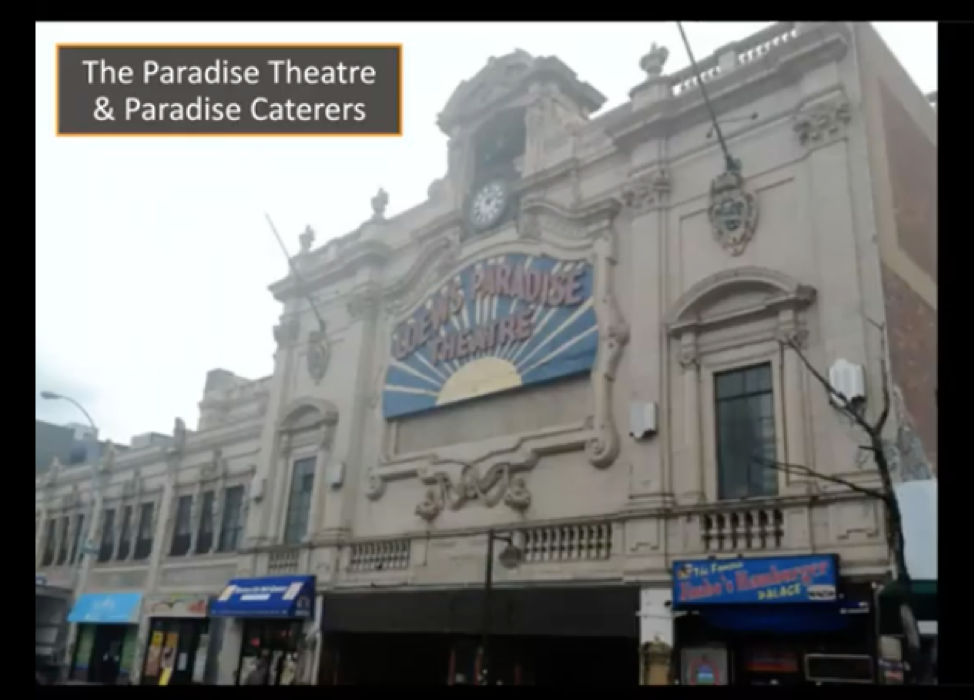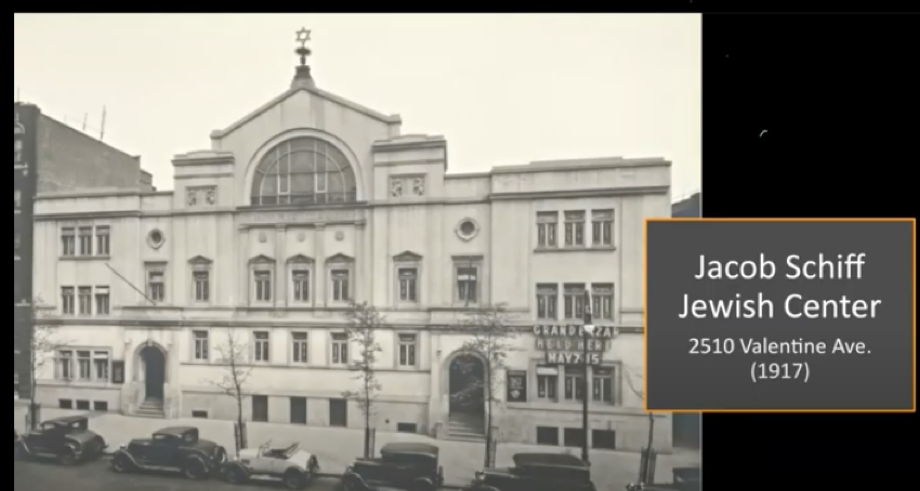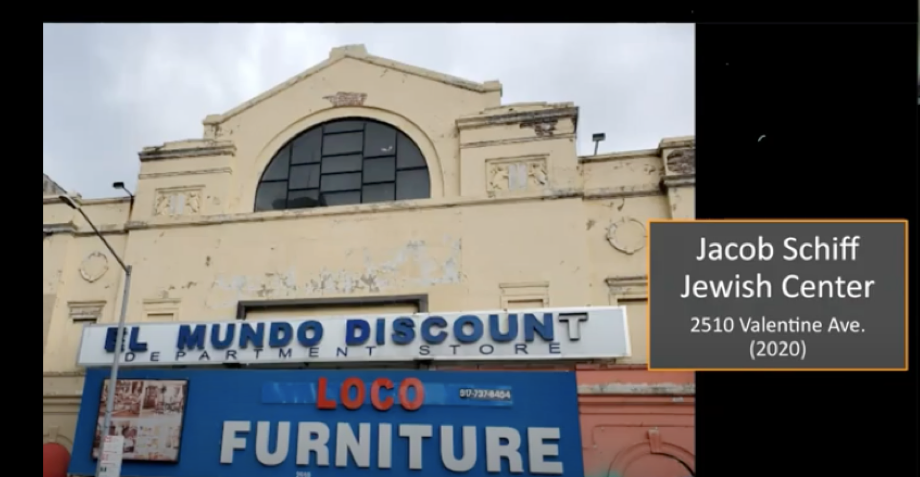Remnants of the Jewish Bronx: A Tour of Buildings Devoid of People
By Sue Weston and Susie Rosenbluth, Two Sues on the Aisle
“Remnants of the Jewish Bronx” a walking tour, sponsored by the Lower East Side Jewish Conservancy (LESJC), attracted attention from Jewish history buffs and former residents of “Da Bronx”. Unable to hold their walking tours during the pandemic, the LESJC pivoted offering virtual tours including the Jewish migration to the Bronx, home for the largest Jewish population (more than 360,000 in 1930, and about 650,000 after World War II) of all five boroughs of New York City and more than 200 synagogues in addition to a plethora of other Jewish institutions.
Boulevard of Dreams
Our guide was Bronx native Susan Birnbaum who, as Susan Sez, hosts many NYC walkabouts. She began by sharing sites and scenes of the Boulevard of Dreams, the Grand Concourse, which included different types of shuls catering to a wide variety of Jewish communities and the very popular Paradise Theater and Caterers, built in 1929. Known for its iconic goldfish pond, starred ceiling, and chandeliers, the movie palace was rented for High Holiday services attended by an overwhelming number of unaffiliated Jews.
Like so many of the synagogues that dotted the streets and neighborhoods of the Bronx, the Paradise Theater was leased by the World Changers Church International.

Early Jewish Arrivals
The first Jews to settle in The Bronx in appreciable numbers came in the 1840s. Mostly German and Hungarian peddlers and artisans, they came to work in the construction of the Harlem and Hudson railroad. These Jews traveled to Manhattan for services, as no synagogues existed in the Bronx.
The first recorded Jewish institution was a Sunday School, organized in 1884 and later incorporated in 1891 as Temple Hand in Hand, a Reform congregation on East 145th Street. According to Ms. Birnbaum, the concept was to provide social programs and, thus, attract Jews to come to services.
Following the pattern of so many other Jewish houses of worship, Temple Hand in Hand consolidated with the Sinai Congregation of the Bronx in 1914, and new synagogue, Beth Hamedrash Hagadol Jeshurun, occupied the building.
Now Churches
While many of the synagogue buildings included in Ms. Birnbaum’s narrative are now used by churches, their former lives are reflected in the buildings’ styles and appointments including stained-glass windows with depictions from the Hebrew Bible and the ubiquitous Stars of David.
The Jacob Schiff Jewish Center, was a prominent culture center and synagogue on Valentine Avenue near the intersection of Fordham Road and the Grand Concourse, from the 1930s through the 1960s. Today, the building retains its majestic design, including friezes of Lions of Judah but it functions as El Mundo/Super Mundo Discount Department Store.

Jacob Schiff Jewish Center 1917 
Migrations
The countless synagogues of all denominations followed similar patterns. Ms. Birnbaum described their evolutions, transformations, and mergers. These changes chronicled the Jewish migration, as areas were made accessible by the expansion of the subway system, the construction of the Cross Bronx Expressway. In the 1970s, the completion of Co-op City, a cooperative housing development built on former marshland that had been occupied by the Freedomland USA Amusement Park offered an attractive option to Bronx residents.
Eventually, most of the Jews in the Bronx left for other areas. Riverdale, located in the northwest corner of the Bronx, still enjoys a sizable Jewish community of more than 20,000.
Andrew Freedman Home
Perhaps one of Ms. Birnbaum’s most delightful stories was the one concerning the Andrew Freedman Home, located at 1125 Grand Concourse.
During the Panic of 1907, Mr. Freedman, a self-made millionaire and investor who had owned the New York Giants and was responsible for the first New York subway line, came perilously close to losing his entire fortune. Convinced that poverty struck hardest at people who had once enjoyed financial success and then lost all their worldly possessions, he left his estate, including a Renaissance Palazzo-styled villa, to serve as an old-age home for the formerly wealthy. His goal was to allow them to retire in the “proper style” to which they had once become accustomed.
It served this purpose, allowing couples and seniors to live out their twilight years in charm and elegance, until 1983, when the property was acquired by the Mid-Bronx Senior Citizens Council which used it as an adult residential facility for seniors who had never been wealthy. When financial difficulties forced the facility to close, the villa became a center providing many community services for the area.
Today, the landmark building is a center for art, culture, learning, and creativity whose gallery attracts artists of all ages.
Last Deli
The tour was undeniably bittersweet, a retrospective history of an area that at one time was a thriving hub of Jewish culture that was slowly abandoned.
Ms. Birnbaum discussed a case in point, Liebman’s Deli on West 235th Street near Johnson Avenue. When it opened in 1953, Liebman’s was one of more than 100 such kosher delis in the Bronx. Now, its owners say, it is the last one standing.
Open seven days a week and bearing no hechsher certifying its kashrut, Liebman’s would not be suitable for the growing Orthodox-Jewish community in nearby Riverdale, which is cultivating its own slew of glatt kosher establishments.
What about the People?
One wishes Ms. Birnbaum had devoted more time to the lives of the Jewish residents who inhabited the buildings near the one-time shuls and had discussed the turmoil that must have accompanied the ebb and flow of the borough’s economy and prosperity. She had many pictures, but the story of regentrification and transformation was missing. Who were the Jews who moved the shuls from the Bronx to Westchester? Why did they move? Why did so many shuls have to merge to stay afloat?
The stories of rebirth, the forms and functions that must evolve to meet the needs of the next group of residents, the reasons behind the abundance of one-time shuls that are today churches were missing from this otherwise fascinating tour.
***
Two Sues on the Aisle bases its ratings on how many challahs it pays to buy (rather than make) in order to see the play, show, film, or exhibit being reviewed. (5 Challah is our highest rating)






